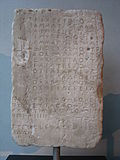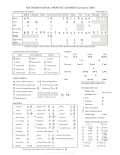sýstīma grafī́s), which includes five diacritics, notates Ancient Greek phonology. The simpler monotonic orthography (Greek: μονοτονικό σύστημα γραφής, romanized: monotonikó...
34 KB (2,701 words) - 15:39, 22 October 2024
Ancient Greek (Ἑλληνῐκή, Hellēnikḗ; [hellɛːnikɛ́ː]) includes the forms of the Greek language used in ancient Greece and the ancient world from around...
48 KB (5,246 words) - 07:27, 21 November 2024
adjective. Some diacritics, such as the acute ⟨ó⟩, grave ⟨ò⟩, and circumflex ⟨ô⟩ (all shown above an 'o'), are often called accents. Diacritics may appear...
104 KB (8,878 words) - 15:38, 24 October 2024
and Ancient Greek now use different diacritics, with ancient Greek using the polytonic orthography and modern Greek keeping only the stress accent (acute)...
114 KB (8,945 words) - 17:30, 21 November 2024
umlaut diacritics with vowels, diaeresis above e occurs in a few proper names, such as Ferdinand Piëch and Bernhard Hoëcker. In Modern Greek, αϊ and...
17 KB (1,972 words) - 14:01, 13 November 2024
Alpha (redirect from Alpha (Greek))
Greek characters, see Greek diacritics: Computer encoding): U+0251 ɑ LATIN SMALL LETTER ALPHA U+0252 ɒ LATIN SMALL LETTER TURNED ALPHA U+0386 Ά GREEK...
11 KB (1,347 words) - 19:24, 22 October 2024
Epsilon (redirect from Epsilon (Greek))
efficiency" of a particular plant or crop. For accented Greek characters, see Greek diacritics: Computer encoding. U+0190 Ɛ LATIN CAPITAL LETTER OPEN E...
18 KB (2,267 words) - 14:31, 22 October 2024
Smooth breathing (redirect from Greek spiritus lenis)
U+1FBF ᾿ GREEK PSILI. The coronis is assigned two distinct code points, U+1FBD ᾽ GREEK KORONIS and U+0343 ◌̓ COMBINING GREEK KORONIS. Greek diacritics Rough...
6 KB (656 words) - 19:11, 22 October 2024
Iota (redirect from Iota (Greek))
code point U+03B9 and the uppercase U+0399. For accented Greek characters, see Greek diacritics: Computer encoding. U+0196 Ɩ LATIN CAPITAL LETTER IOTA U+0269...
5 KB (726 words) - 08:24, 22 October 2024
ë). For non-Latin scripts, Greek and Russian use press-and-hold for double-dot diacritics on only a few characters. The Greek keyboard has dialytica and...
26 KB (3,077 words) - 03:27, 23 October 2024
Library of Alexandria (category Articles containing Ancient Greek (to 1453)-language text)
steam engine; Aristophanes of Byzantium, who invented the system of Greek diacritics and was the first to divide poetic texts into lines; and Aristarchus...
85 KB (10,126 words) - 21:49, 20 November 2024
Katharevousa (redirect from Katharevusa Greek language)
his exaggerated sentiments against the clergy. Demotic Greek Diglossia Greek diacritics Greek language question Linguistic purism Similar movements Landsmål...
11 KB (958 words) - 17:31, 22 October 2024
International Phonetic Alphabet (redirect from IPA diacritics)
lowering diacritics have optional spacing forms ⟨˔⟩, ⟨˕⟩ that avoid descenders. The state of the glottis can be finely transcribed with diacritics. A series...
166 KB (16,108 words) - 22:18, 16 November 2024
Though the standard diacritic involved is a macron, there are no other diacritics used above letters, so in practice other diacritics can and have been...
33 KB (3,454 words) - 09:55, 14 November 2024
Tittle (category Diacritics)
related). "Keraia" is a hook or serif, and in Matthew 5:18 may refer to Greek diacritics, or, if the reference is to the Hebrew text of the Torah, possibly...
10 KB (1,083 words) - 07:13, 25 October 2024
generally referred to by speakers simply as Greek (Ελληνικά, Elliniká), refers collectively to the dialects of the Greek language spoken in the modern era, including...
31 KB (3,240 words) - 20:58, 14 November 2024
Greek (Modern Greek: Ελληνικά, romanized: Elliniká, [eliniˈka]; Ancient Greek: Ἑλληνική, romanized: Hellēnikḗ) is an Indo-European language, constituting...
70 KB (7,082 words) - 23:02, 17 November 2024
through other breathing organs. Breathing may also refer to: One of two Greek diacritics: Rough breathing, which represents h Smooth breathing, which represents...
2 KB (247 words) - 21:36, 10 February 2024
symbols. Greek numerals, also known as Ionic, Ionian, Milesian, or Alexandrian numerals, is a system of writing numbers using the letters of the Greek alphabet...
29 KB (2,504 words) - 02:12, 7 November 2024
Circumflex (category Greek-script diacritics)
§ Brackets and transcription delimiters. The circumflex (◌̂) is a diacritic in the Latin and Greek scripts that is also used in the written forms of many languages...
35 KB (3,823 words) - 20:46, 14 November 2024
over ..." "Diacritics & Special Characters". University of North Carolina. The following diacritics and special characters display: Diacritics: acute Á ;...
26 KB (3,215 words) - 10:02, 22 October 2024
Inverted breve (redirect from Arch (diacritic))
Smyth. Greek Grammar. par. 20 a: semivowels. "LaTeX for Classical Philologists and Indo-Europeanists". Retrieved 2010-09-23.[dead link] Diacritics Project...
5 KB (395 words) - 15:43, 28 August 2024
Mu (letter) (redirect from Mu (Greek))
(/ˈm(j)uː/; uppercase Μ, lowercase μ; Ancient Greek μῦ [mŷː], Greek: μι or μυ—both [mi]) is the twelfth letter of the Greek alphabet, representing the voiced bilabial...
10 KB (1,257 words) - 01:30, 27 October 2024
Rough breathing (category Greek-script diacritics)
nearer to the Greek dasia than the Semitic ayin). Greek diacritics Smooth breathing Ayin ( ʿ ) ʻOkina ( ʻ ) Herbert Weir Smyth, Greek Grammar, par. 14...
8 KB (930 words) - 14:09, 25 October 2024
Chi (letter) (redirect from Chi (Greek letter))
χ; Greek: χῖ) is the twenty-second letter of the Greek alphabet. Its value in Ancient Greek was an aspirated velar stop /kʰ/ (in the Western Greek alphabet:...
7 KB (838 words) - 03:08, 10 November 2024
Beta (redirect from Beta (Greek))
ϐ; Ancient Greek: βῆτα, romanized: bē̂ta or Greek: βήτα, romanized: víta) is the second letter of the Greek alphabet. In the system of Greek numerals,...
12 KB (1,342 words) - 13:51, 7 November 2024
from the Arabic to the Latin alphabet in 1928, it adopted a number of diacritics borrowed from various languages, including ⟨ü⟩ and ⟨ö⟩ from German (probably...
18 KB (2,071 words) - 21:29, 24 October 2024
(P)SEE (uppercase Ψ, lowercase ψ or 𝛙; Greek: ψι psi [ˈpsi]) is the twenty-third and penultimate letter of the Greek alphabet and is associated with a numeric...
7 KB (860 words) - 01:34, 7 November 2024
Iota subscript (category Greek-script diacritics)
The iota subscript is a diacritic mark in the Greek alphabet shaped like a small vertical stroke or miniature iota ⟨ι⟩ placed below the letter. It can...
15 KB (1,743 words) - 14:30, 3 April 2024
Rho (redirect from Rho (Greek))
uppercase Ρ, lowercase ρ or ϱ; Greek: ρο or ρω) is the seventeenth letter of the Greek alphabet. In the system of Greek numerals it has a value of 100...
6 KB (896 words) - 01:19, 27 October 2024










